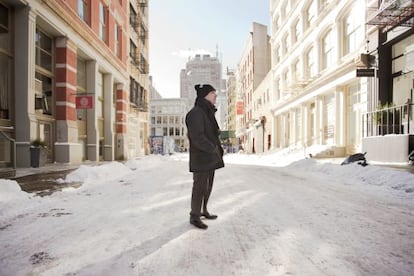Ferran Adrià cooks up some art
The widely acclaimed chef will be taking center stage at the EL PAÍS stand at ARCO


The show is about to start. We have found the combination that opens the safe of gastronomy. This is really heavy duty stuff but will it work or not? Everything we've been through during these last two years of silent work and thinking, of hiding out, of investigating what cuisine is all about, what cooking is all about, what creating is all about, finding out where we come from and where we are headed, and then conceptualizing that by analyzing the experience and information we've accumulated after 30 years at elBulli, and having the ability to share it with people through new technologies and in dialogue with other disciplines... There is no going back. It's the kind of shot in the arm that cuisine needed. It's been two long years to reflect and put things in order. But everything is finally falling into place."
The unstoppable flow of words pours out of Ferran Adrià as he sits back with a distant look in his eyes. Snow is blowing hard against the windows of the dilapidated train that is carrying him from Boston to New York. Sitting next to him is his wife Isabel Pérez, who is also his interpreter, and the tray before him is littered with junk food — not the kind of nourishment one associates with the gastronomic universe of a chef who has revolutionized haute cuisine with his visionary work, become a leading light for several generations of chefs and turned the whole food experience into a declaration of independence, freedom and a search for happiness like no other before him.
For years, it all came together in elBulli, a small restaurant out in the middle of a beautiful and remote cove in northern Girona. For five years it was considered the best restaurant in the world by the media, and by the time it closed down in July 2011, it had become an icon.

"elBulli didn't die," explains Adrià, 51. "We were not bankrupt or bereft of ideas, and we were not poisoning people. I didn't get into a fight with my business partner. I did not become an idle celebrity who charges 80,000 euros for every lecture. We were simply looking further. We were ahead of the curve. We wanted to keep creating at the same level we were used to, without falling into repetition, auditing ourselves continuously and mercilessly. We didn't want to let ourselves get carried away by the tedium and the pressure of day-to-day work at the restaurant. We wanted to offer something more. And a restaurant was no longer the right vehicle for that. In 2009, when I made the decision to take two years out beginning in 2011, elBulli was turning into a monster that was threatening to devour us. Our antidote was to come up with a tool for education and creativity that is not limited to the world of cooking but can be useful in other disciplines. We have created a massive network that includes Barcelona University, which will coordinate and build consensus around the bullipedia [a vast database drawn up by a tiny team from elBulli in an attempt to order and classify all knowledge in Western cooking], in tandem with the scientific community and the greatest business and restaurant schools. We also have technological support from Telefónica, Harvard and MIT."
It was at the Massachusetts Institute of Technology that Adrià recently joined a brainstorming session with a dozen wise men and women from a variety of disciplines, including vice-president Israel Ruiz and the architects Antón García-Abril and Enric Ruiz-Geli, to discuss the conceptual future of the elBulli foundation.
"elBulli has morphed; never again will it be the restaurant that received two million reservation requests, of which we could only honor 6,000; but its spirit is more alive and generous than ever through the elBullifoundation, which will start out with working capital of 20 million euros from our own pockets, and will be headquartered next to the former restaurant. It will become a testing ground inside a campus that covers nearly 6,000 square meters. In a couple of years this will be an interdisciplinary center with no rules; it will be expositional and creative. It will be an anti-museum."
The Amtrak train carrying Adrià to the Big Apple was the last one allowed out of Boston on Tuesday night. After that, the tracks were closed off because of the snow storm that beat down on the northeast with temperatures of -20ºC.
The chef and guru was on his way to SoHo to inaugurate a show called Notes on creativity at The Drawing Center, a small and very exclusive museum for connoisseurs located inside a 19th-century industrial building. Its focus is on drawing in connections with other disciplines, from architecture to science. The Drawing Center has shown work by Victor Hugo, Louis Kahn, Emily Dickinson, Richard Serra, Louise Bourgeois and Sean Scully, among others.
The Friday premiere gave way to a month-long show that lets visitors gaze upon the esthetic and philosophical products to come from Adrià's imagination, intuition and pencil (which always rests strategically atop his right ear). These take the form of hundreds of febrile sketches, diagrams, notes and drawings that have allowed him to unravel the genome of the gastronomic process.

But this inauguration was only one of two new art-related projects for Ferran Adrià: the chef will also be the guest artist at the EL PAÍS stand at the upcoming edition of ARCO, the international art fair that opens in Madrid on February 19. Since 1992, ARCO has hosted some of the biggest names in contemporary Spanish art, from Barceló and Tàpies, to Chillida, Palazuelo and Eduardo Arroyo. With the turn of the century the fair has adopted a more provocative tone, inviting the likes of the photographer Alberto García Alix and the Posgrafitti collective.
As for Adrià, ARCO will showcase 200 previously unseen documents and drawings made over the last two years. The doodles, which occasionally look almost like cryptograms, underscore the chef's obsession with deciphering the physical and intellectual hieroglyphs of the kitchen and conveying its meanings to the wider world.
The material that will be on display at the EL PAÍS stand is grouped in two: first there are the preliminary sketches that he put down on paper, often late at night, in his small Barcelona apartment, or else in airport waiting areas, on napkins and air-sickness bags. It is part of the effort to decode the gastronomic project by examining every last minute particle of all of the products, techniques, spaces and tools used in the universe of cooking. And everyone is a participant in this project. Therein lies the key to elBulli 2.0. After a frantic year-and-a-half, the decoding work has materialized into a highly complex, dramatic-looking diagram created by Bestiario (a company that straddles algorithms and art, turning large amounts of disconnected data into clear, efficient information of great visual beauty). The end result will be an infinitely useful guide to the secrets of cooking.
The second chunk of material is made up of 60 original artworks by Adrià. The small oil paintings, in which the chef used his fingers rather than paintbrushes, are reminiscent of Basquiat in their rusticity and rotundity. Their subject matter is the evolution of humanity in relation with the evolution of cuisine.
"When I took it upon myself to understand what it is to cook, I had to dive into the origins of the human race, its evolution. When and how did cooking start? I spoke with scholars at Atapuerca, with paleontologists and archeologists. And later I reflected on the first time that humans used fire, on the great migrations, the Neolithic, the birth of civilizations. There were no visual references, so in order to think clearer I came up with my own historical compositions. My only aspiration was to understand the world better. All this work can be seen at ARCO."
Adrià is no artist. Nor is he an intellectual. At the most, he is an agitator, a provocateur, a sponge, a bohemian who never set foot in a university until he was granted honorary degrees by four of them. These days, he is the closest thing Spain has to a global gastronomy guru. Above all, he is someone who knows all about creation. His entire life has been a race to learn and express everything that is bubbling inside of him. For three decades he managed that through the language of cuisine. But there is a lot more behind it.
Tu suscripción se está usando en otro dispositivo
¿Quieres añadir otro usuario a tu suscripción?
Si continúas leyendo en este dispositivo, no se podrá leer en el otro.
FlechaTu suscripción se está usando en otro dispositivo y solo puedes acceder a EL PAÍS desde un dispositivo a la vez.
Si quieres compartir tu cuenta, cambia tu suscripción a la modalidad Premium, así podrás añadir otro usuario. Cada uno accederá con su propia cuenta de email, lo que os permitirá personalizar vuestra experiencia en EL PAÍS.
¿Tienes una suscripción de empresa? Accede aquí para contratar más cuentas.
En el caso de no saber quién está usando tu cuenta, te recomendamos cambiar tu contraseña aquí.
Si decides continuar compartiendo tu cuenta, este mensaje se mostrará en tu dispositivo y en el de la otra persona que está usando tu cuenta de forma indefinida, afectando a tu experiencia de lectura. Puedes consultar aquí los términos y condiciones de la suscripción digital.
Últimas noticias
Maduro pleads not guilty before the federal court in New York: ‘I am still the president of Venezuela’
A new test can detect Alzheimer’s from a finger prick
UN team enters Sudanese city of El Fasher after paramilitary massacre: ‘It’s like a ghost town’
A recipe for resistance: Indigenous peoples politicize their struggles from the kitchen
Most viewed
- Gilles Lipovetsky: ‘If you want to live better and fall in love, take Prozac, don’t look to philosophy’
- Alain Aspect, Nobel laureate in physics: ‘Einstein was so smart that he would have had to recognize quantum entanglement’
- Alvin Hellerstein, a 92-year-old judge appointed by Bill Clinton, to preside over Maduro’s trial in New York
- Why oil has been at the center of Venezuela-US conflicts for decades
- Cuba confirms death of 32 of its citizens in the US attack against Venezuela








































